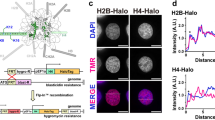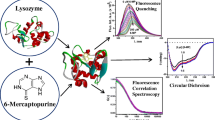Abstract
Alfin1-like (AL) is a family of proteins homologous to the alfalfa Alfin1 in plant and bears an Alfin domain and a PHD domain at their N- and C-terminus, respectively. There are 7 AL proteins in Arabidopsis, and the PHD domains of most AL proteins are reported to bind to histone H3K4me3. Here we reported gene cloning, protein expression and purification of the PHD domains of all the AL family proteins in Arabidopsis. We then systematically characterized their histone binding abilities by quantitative isothermal titration calorimetry and fluorescence polarization binding assays. Our binding results indicate that all the PHD domains of the AL proteins bind to the histone H3K4me3 peptide with varying methylation state preference and binding affinities. Our study presented here provides the foundation for further studies of the peptide state-specific recognition by PHD domains of AL proteins.




Similar content being viewed by others
References
Lee WY, Lee D, Chung WI, Kwon CS (2009) Arabidopsis ING and Alfin1-like protein families localize to the nucleus and bind to H3K4me3/2 via plant homeodomain fingers. Plant J 58:511–524
Molitor AM, Bu Z, Yu Y, Shen WH (2014) Arabidopsis AL PHD-PRC1 complexes promote seed germination through H3K4me3-to-H3K27me3 chromatin state switch in repression of seed developmental genes. PLoS Genet 10(1):e1004091
Bastola DR, Pethe VV, Winicov I (1998) Alfin1, a novel zinc-finger protein in alfalfa roots that binds to promoter elements in the salt-inducible MsPRP2 gene. Plant Mol Biol 38:1123–1135
Zhao S, Zhang B, Yang M, Zhu J, Li H (2018) Systematic profiling of histone readers in Arabidopsis thaliana. Cell Rep 22:1090–1102
Schindler U, Beckmann H, Cashmore AR (1993) HAT3.1, a novel Arabidopsis homeodomain protein containing a conserved cysteine-rich region. Plant J 4:137–150
Bienz M (2006) The PHD finger, a nuclear protein-interaction domain. Trends Biochem Sci 31:35–40
Vaquero A, Loyola A, Reinberg D (2003) The constantly changing face of chromatin. Sci Aging Knowl Environ 2003:RE4
Strahl BD, Allis CD (2000) The language of covalent histone modifications. Nature 403:41–45
Pena PV, Davrazou F, Shi X, Walter KL, Verkhusha VV, Gozani O, Zhao R, Kutateladze TG (2006) Molecular mechanism of histone H3K4me3 recognition by plant homeodomain of ING2. Nature 442:100–103
Li H, Ilin S, Wang W, Duncan EM, Wysocka J, Allis CD, Patel DJ (2006) Molecular basis for site-specific read-out of histone H3K4me3 by the BPTF PHD finger of NURF. Nature 442:91–95
Lan F, Collins RE, De CR, Alpatov R, Horton JR, Shi X, Gozani O, Cheng X, Shi Y (2007) Recognition of unmethylated histone H3 lysine 4 links BHC80 to LSD1-mediated gene repression. Nature 448:718–722
Adams-Cioaba MA, Min J (2009) Structure and function of histone methylation binding proteins. Biochem Cell Biol (Biochimie et biologie cellulaire) 87:93–105
Zeng L, Zhang Q, Li SD, Plotnikov AN, Walsh MJ, Zhou MM (2010) Mechanism and regulation of acetylated histone binding by the tandem PHD finger of DPF3b. Nature 466:258–262
Li W, Zhao A, Tempel W, Loppnau P, Liu Y (2016) Crystal structure of DPF3b in complex with an acetylated histone peptide. J Struct Biol 195:365–372
Qiu Y, Liu L, Zhao C, Han C, Li F, Zhang J, Wang Y, Li G, Mei Y, Wu M (2012) Combinatorial readout of unmodified H3R2 and acetylated H3K14 by the tandem PHD finger of MOZ reveals a regulatory mechanism for HOXA9 transcription. Genes Dev 26:1376–1391
Liu Y, Liu S, Yang T, Guo X, Jiang Y, Zahid KR, Liu K, Liu J, Yang J, Zhao H (2015) Expression, crystallization and preliminary X-ray diffraction analyses of Med-ORF10 in the biosynthetic pathway of an antitumor antibiotic medermycin. Protein J 34:404–410
Ali M, Rincón-Arano H, Zhao W, Rothbart SB, Tong Q, Parkhurst SM, Strahl BD, Deng LW, Groudine M, Kutateladze TG (2013) Molecular basis for chromatin binding and regulation of MLL5. Proc Natl Acad Sci USA 110:11296–11301
Liu Y, Min J (2016) Structure and function of histone methylation-binding proteins in plants. Biochem J 473:1663–1680
Thompson JD, Higgins DG, Gibson TJ (1994) CLUSTAL W: improving the sensitivity of progressive multiple sequence alignment through sequence weighting, position-specific gap penalties and weight matrix choice. Nucleic Acids Res 22:4673–4680
Robert X, Gouet P (2014) Deciphering key features in protein structures with the new ENDscript server. Nucleic Acids Res 42:W320–W324
Schwede T, Kopp J, Guex N, Peitsch MC (2003) SWISS-MODEL: an automated protein homology-modeling server. Nucleic Acids Res 31:3381–3385
Liu Y, Tempel W, Qi Z, Xiao L, Loppnau P, Su Q, Min J (2016) Family-wide characterization of histone binding abilities of human CW domain-containing proteins. J Biol Chem 291:9000–9013
Zhang Y, Lei M, Yang X, Feng Y, Yang Y, Loppnau P, Li Y, Yang Y, Min J, Liu Y (2018) Structural and histone binding studies of the chromo barrel domain of TIP 60. FEBS Lett 592:1221–1232
Acknowledgements
This study was supported by the National Natural Science Foundation of China (Grant No. 31500613); Hubei Chenguang Talented Youth Development Foundation; and the Central China Normal University (CCNU) from the college’s basic research and operation of Ministry of Education (MOE) (Grant No. CCNU18TS020).
Author information
Authors and Affiliations
Contributions
XL, ML, FL and XY purified the proteins and conducted the ITC assays; MZ, BL and YC conducted the FP assays; SG, KL, JL and CQ cloned the constructs; YL conceived and designed the study and wrote the paper. All authors analyzed the data and approved the final version of the manuscript.
Corresponding author
Ethics declarations
Conflict of interest
The authors declare no conflict of interest.
Rights and permissions
About this article
Cite this article
Liang, X., Lei, M., Li, F. et al. Family-Wide Characterization of Histone Binding Abilities of PHD Domains of AL Proteins in Arabidopsis thaliana. Protein J 37, 531–538 (2018). https://doi.org/10.1007/s10930-018-9796-4
Published:
Issue Date:
DOI: https://doi.org/10.1007/s10930-018-9796-4




